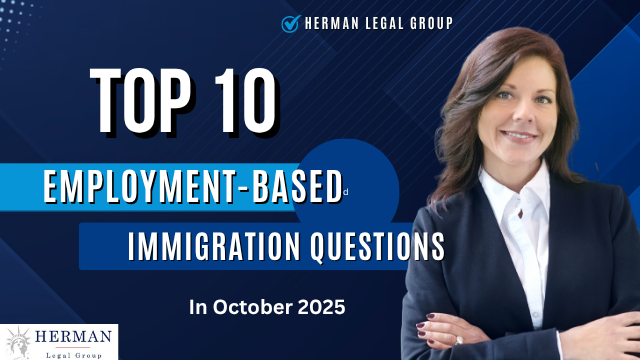Quick Answer Box
- Up to 180 days (≈ 6 months): generally safe, minimal scrutiny
- Over 180 days but less than 1 year: presumptive risk of being treated as seeking admission
- 1 year or more (without reentry permit): high risk of status abandonment; may need SB-1 visa
- With valid reentry permit (Form I-131): you can remain abroad up to 2 years without triggering abandonment
- Always carry: proof of domicile, U.S. tax returns, job/lease, bank statements, family ties, and reentry permit
This comprehensive guide, by Richard T. Herman, Esq., founder of the Herman Legal Group – The Law Firm for Immigrants, explains when a lawful permanent resident (LPR or green card holder) may be treated by U.S. Customs and Border Protection (CBP) as “seeking admission.”
It’s written for everyday travelers and immigration professionals who need clarity on the 180-day, 1-year, and 2-year rules, with embedded official resources for reference.

-
The Legal Anchor: INA § 101(a)(13)(C) Explained in Plain English
Under INA § 101(a)(13)(C) of the Immigration and Nationality Act, a lawful permanent resident who was properly admitted and has not lost status is not treated as seeking admission to the U.S. unless one of six exceptions applies, such as:
- Abandoning or relinquishing LPR status
- Being absent from the U.S. for more than 180 days
- Engaging in criminal activity that makes the person inadmissible
- Leaving while under removal order or proceedings
- Committing immigration fraud or misrepresentation
- Falling under security or health-related inadmissibility grounds
The U.S. Citizenship and Immigration Services (USCIS) elaborates on LPR travel rules on its official USCIS Green Card Travel page.
Key takeaway: a lawful permanent resident normally reenters freely, but crossing the 180-day threshold exposes you to inspection as a new “applicant for admission.” The Catholic Legal Immigration Network (CLINIC) notes that even short absences can cause issues if you appear to have moved abroad.
-
Understanding the Thresholds: <180 Days, >180 Days, 1 Year, 2 Years
Up to 180 Days — Generally Safe
Trips under six months are usually uneventful. CBP officers typically accept these absences as temporary visits abroad, assuming you kept ties to the U.S.
See official guidance at the CBP Returning Residents page.
Over 180 Days but Less Than 1 Year — “Seeking Admission” Zone
Under the statute, if you remain abroad more than 180 days, you may be treated as “seeking admission” under INA § 101(a)(13)(C)(ii).
CBP may:
- Conduct secondary inspection
- Ask about your intent to return
- Review your U.S. tax, housing, or job evidence
See CLINIC’s resource, “Absences That Are Too Long and How to Cure Them”, for nonprofit legal guidance on rebutting abandonment claims.
One Year or More (Without Reentry Permit)
If you’ve been outside the U.S. for one year or longer without a valid reentry permit, your green card alone no longer guarantees entry.
You may be considered to have abandoned your residence, and you’ll likely need a Returning Resident (SB-1) Visa from a U.S. consulate.
The U.S. Department of State provides detailed SB-1 instructions on its Returning Resident Visa page.
Up to Two Years with a Reentry Permit
A valid reentry permit, issued through USCIS Form I-131, allows you to stay abroad up to two years while preserving your status.
Learn more directly from USCIS at its Reentry Permit FAQ.
Important notes:
- Apply while physically in the U.S.
- Valid for 2 years from issuance (not application date)
- No extensions beyond 2 years
- Those with frequent long absences may receive only a 1-year permit
Refer to the USCIS Travel Documents overview for current requirements.
-
Evidence to Carry When Re-Entering the U.S.
To prove you’ve maintained your U.S. domicile, carry original or digital copies of:
- Recent tax returns (filed as a U.S. resident)
- Proof of residence (lease, mortgage, or property tax bill)
- Employment verification (pay stubs, employer letter)
- U.S. bank statements and utility bills
- Family evidence (spouse, children, school enrollment)
- Reentry permit (if applicable)
- Return ticket and purpose of travel
At the port of entry, always express your intent to permanently reside in the U.S..
If questioned, calmly explain:
“I have a home and job in the U.S., file taxes, maintain accounts, and my travel was temporary for family/business reasons.”
CBP provides traveler tips on CBP Help Center Article #1687.
-
How to Apply for a Reentry Permit (Form I-131)
Step-by-Step:
- File Form I-131, Application for Travel Document with USCIS while in the U.S.
- Attend your biometrics appointment.
- Request to have the permit mailed to a U.S. embassy or consulate abroad if you’ll depart early.
- Once issued, the permit is valid for up to two years.
- Present the permit and your green card upon reentry.
Refer to USCIS’s official “How Do I Get a Reentry Permit?” guide (PDF).
-
Red Flags That Trigger Extra Scrutiny
You may face difficulty at CBP or later immigration stages if:
- You have criminal convictions or pending charges
- You failed to file U.S. taxes or filed as a “nonresident”
- You moved your primary residence abroad (sold U.S. home, moved family)
- You had multiple extended absences or inconsistent travel patterns
- You left while your I-131 was pending without attending biometrics
- Your green card expired while abroad
Seek experienced counsel early—preferably from an immigration attorney familiar with CBP inspection protocols.
The American Immigration Lawyers Association (AILA) and nonprofits like CLINIC provide community guidance and attorney directories.
-
Frequently Asked Questions
Q: What if my trip lasted 190 days?
CBP can presume you are seeking admission, but if you show strong U.S. ties, you should still be readmitted as a returning resident.
Q: My flight was canceled and I returned after one year—am I in trouble?
Possibly. You’ll need documentation proving the delay was beyond your control. You may need to apply for a Returning Resident Visa (SB-1).
Q: What if my green card expired while I was abroad?
File Form I-131A to get a boarding foil before traveling back to the U.S.
Q: Can a reentry permit serve as a passport?
In some countries, yes. Check entry rules in advance. Details at the USCIS Reentry Permit FAQ.
Q: What if I left before my I-131 was approved?
You can have it delivered to an embassy abroad, but you must have attended biometrics first.
-
Key Government and Nonprofit Resources
U.S. Government Sources
- USCIS Travel Documents Overview
- USCIS Reentry Permit Guide (PDF)
- Form I-131 Application for Travel Document
- CBP Returning Residents Resource
- CBP Help Center Article #1687
- State Department: SB-1 Returning Resident Visa
Nonprofit & Legal Support
- Catholic Legal Immigration Network (CLINIC)
- American Immigration Lawyers Association (AILA)
- Immigration Advocates Network
- National Immigration Forum
Herman Legal Group Resources
- Herman Legal Group – The Law Firm for Immigrants
- Book a Consultation
- About Richard T. Herman
- Travel Warning for Visa and Green Card Holders
Key Takeaways
- Under INA § 101(a)(13)(C), a green card holder is generally not “seeking admission” unless certain conditions (like absences over 180 days) apply.
- Trips under 180 days are typically safe; over 180 days invite extra scrutiny.
- Absence over 1 year without a reentry permit risks abandonment of residency.
- A USCIS reentry permit allows up to 2 years abroad and shows intent to keep U.S. residence.
- Carry strong documentation: taxes, housing, job, and family ties.
- Consult an experienced attorney like Herman Legal Group before extended travel.
Author Bio / Profile

Richard T. Herman, Esq. is a nationally recognized immigration attorney with over 30 years of experience representing families, businesses, and immigrants worldwide. He is the co-author of Immigrant, Inc. and the founder of the Herman Legal Group – The Law Firm for Immigrants.
To learn more or schedule a confidential consultation, visit his bio page or book a consultation here.








